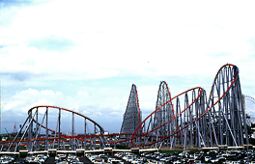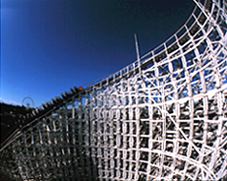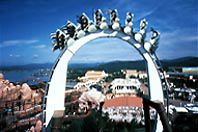WHAT'S COOL IN JAPAN July-September 2000 |
|
Exciting New Roller Coasters
|
|
Over the past few years in Japan, new types of roller coasters of all shapes and sizes have appeared, including giant-sized coasters, wooden coasters, and ones where the riders' legs dangle freely throughout the run.
In July 1996, Fujiyama, a roller coaster with a maximum height of 79 meters (259 feet) and a vertical drop of 70 meters (230 feet) was completed at Fujikyu Highland in Yamanashi Prefecture near Tokyo, becoming Japan's biggest roller coaster and attracting the attention of Japanese youth. Blasting around a 2,045-meter- (6,709-foot-) long track in 3 minutes and 36 seconds at a top speed of 130 kilometers (81 miles) per hour, the ride was listed in the Guinness Book of World Records as the world's "tallest traditional complete circuit roller coaster."  In August 2000, however, an even bigger coaster was built in Mie Prefecture's Nagashima Spaland near the city of Nagoya, in the heart of Honshu. Named Steel Dragon 2000, the coaster's height, speed, drop, and length are all tops in the world, prompting a rewriting of the Guinness record book.
In August 2000, however, an even bigger coaster was built in Mie Prefecture's Nagashima Spaland near the city of Nagoya, in the heart of Honshu. Named Steel Dragon 2000, the coaster's height, speed, drop, and length are all tops in the world, prompting a rewriting of the Guinness record book.
The coaster, named for the way its red-painted track zigzags through the sky like a dragon, features a 36-person ride that drops 93.5 meters (307 feet) from its highest point of 97 meters (318 feet) at a 68-degree angle. To the rider, this angle virtually looks and feels like a vertical drop. The coaster races along a 2,479-meter (8,133-foot) track at a top speed of 153 kilometers (95 miles) per hour, the world's fastest, providing 3 minutes and 30 seconds of excitement. Some more unusual varieties of roller coasters have also recently made their debut. Regina, constructed in March 2000 in Saitama Prefecture neighboring Tokyo, is a 1,334-meter- (4,377-foot-) long wooden coaster built on top of a 2.6-hectare pond. In addition to the uniqueness of riding on top of water, because wood bends somewhat when force is applied to it, the coaster rattles more than steel-made types.  Another wooden roller coaster, Yomiuri Land's White Canyon in Tokyo, features sharp curves. At 1.5 Gs, the maximum force that is applied on the rider's body when passing through a sideways curve is the highest in Japan. When getting off the coaster after a ride, riders may feel as though the insides of the stomach have jolted to one side. Parque Espana in Mie Prefecture features Pyrenees, a 1,234-meter (4,049-foot) inverted roller coaster with the cars suspended from the track instead of coasting over the top. After climbing a 45-meter (148-foot) hill, riders race around spiraling tracks and hairpin curves at a top speed of 100 kilometers per hour. Going through all this with legs dangling in the air provides them with a new type of thrill. 
Osaka's Expoland boasts Fujin Raijin II, a standing roller coaster that runs a length of 1,050 meters (3,445 feet). According to one visitor, the rider was "so scary that I was about to pass out." How far will they go in creating even more thrilling, radical rides? Kids in Japan will have to keep a close eye on all the cool new types of coasters appearing.
Photos: (Top) Nagashima Spaland's Steel Dragon 2000, boasting four world records (Nagashima Spaland); (middle) Yomiuri Land's wooden roller coaster, White Canyon (Yomiuri Land); (above) Parque Espana's inverted coaster, Pyrenees ( (c) SHIMA SPAIN VILLAGE CO., LTD.). |
 |